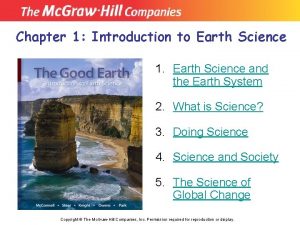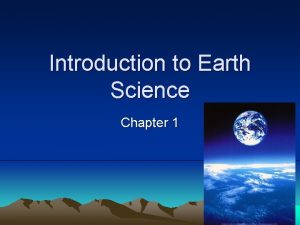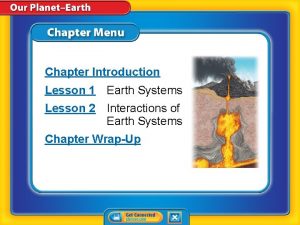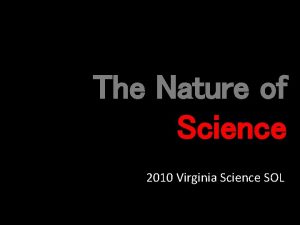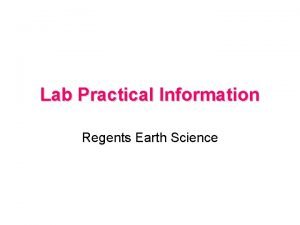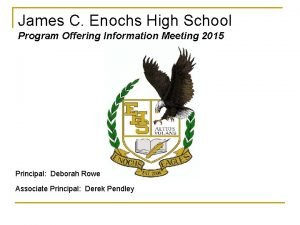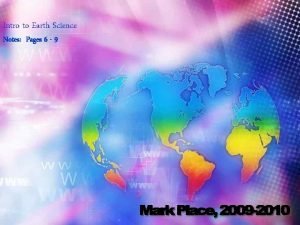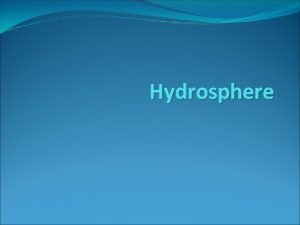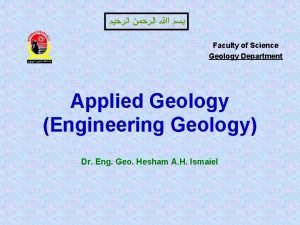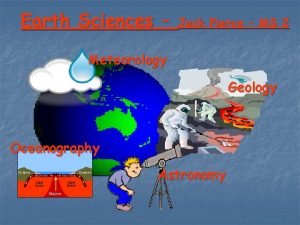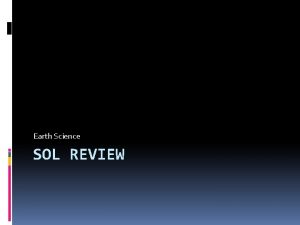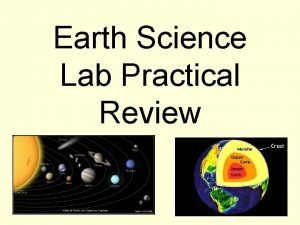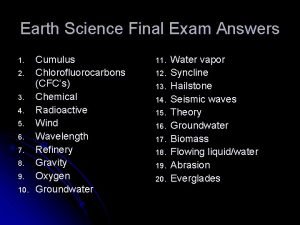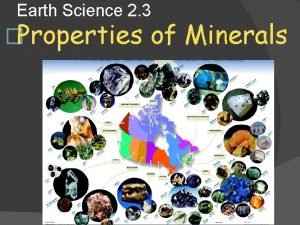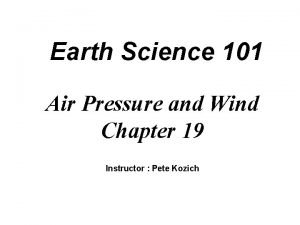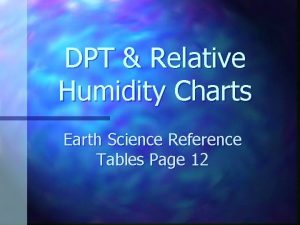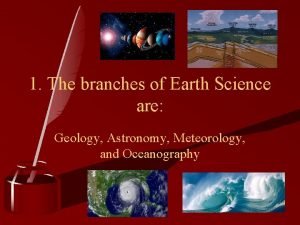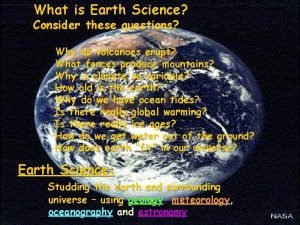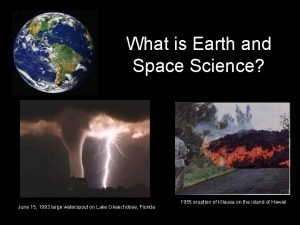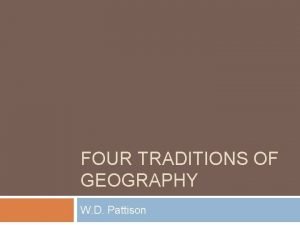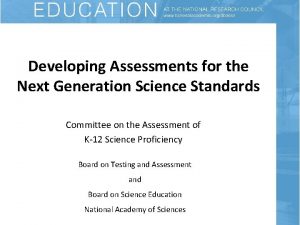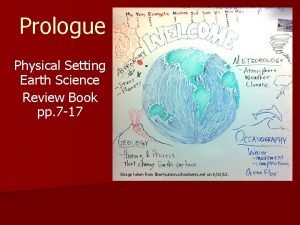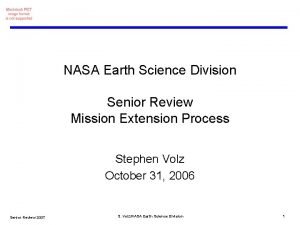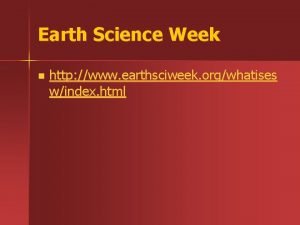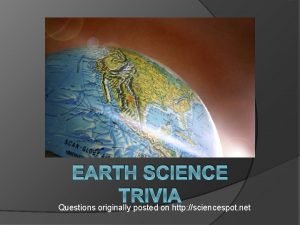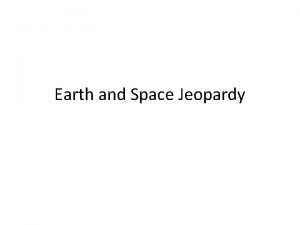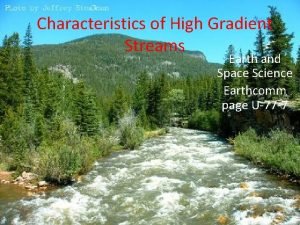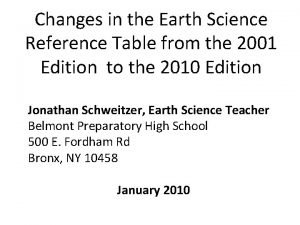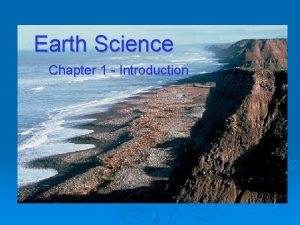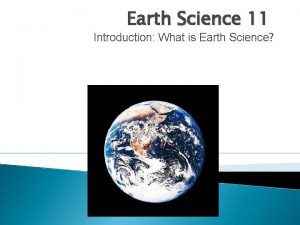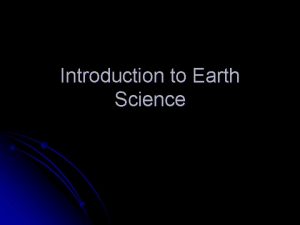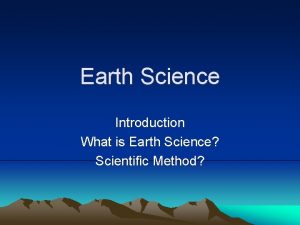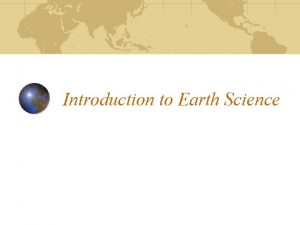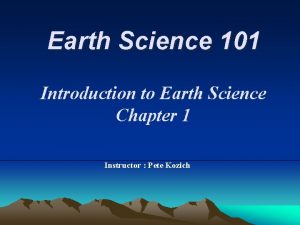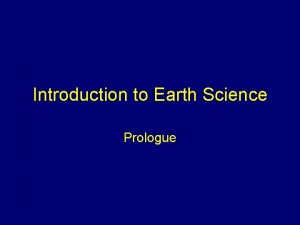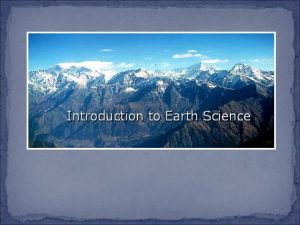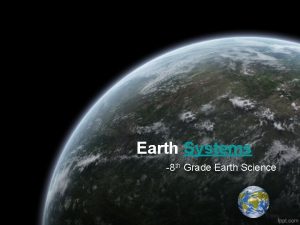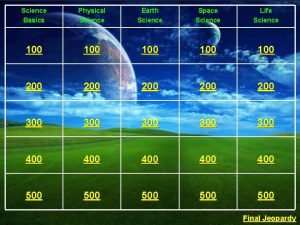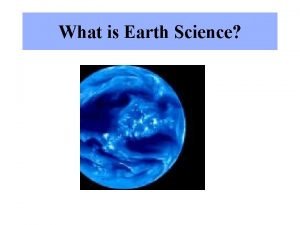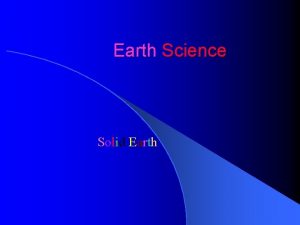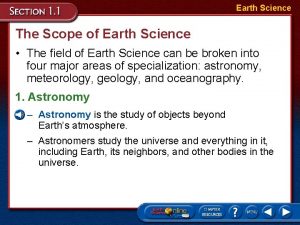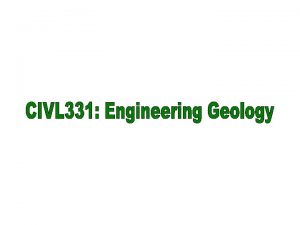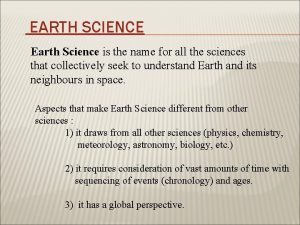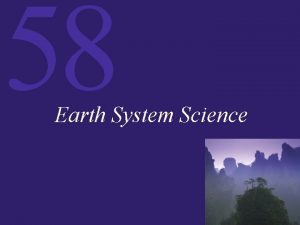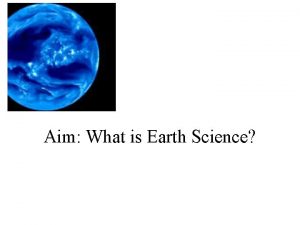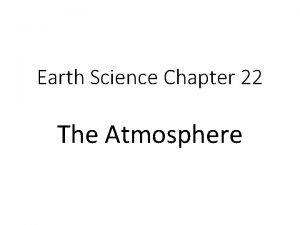Introduction to Earth Science What is Earth Science











































- Slides: 43

Introduction to Earth Science!!!

What is Earth Science? Earth Science is the study of earth and it’s events. Not just solid earth, but everything it’s a part of. Ex. the air surrounding the earth (atmosphere)

What is Earth Science? • What are the 4 branches of E. S. ? Read pgs. 2 -3 • Geology • Astronomy • Meteorology • Oceanography

Which picture belongs to which branch of Earth Science? METEOROLOGY

Which branch? GEOLOGY

How about this branch? ASTRONOMY

Last but not least…. OCEANOGRAPHY

Geology- Study of the Earth’s origin, history and structure.

Activities of Today’s Geologists TOPIC 2 What are some activities? pg. 4

Astronomy- the study of space and the universe

Topic 3 - What Astronomers do

Meteorology- the study of weather and climate

Topic 4 - What Meteorologists Do

Oceanography- the study of the oceans.

What Oceanographers Do

Question: Where does the study of Earth Science begin? Origin of the Earth the solar system Hypothesis: an informed guess that tries to explain how or why an event occurs The hypothesis of the formation of the solar system must include the following facts about the solar system:

1. All planets move around the sun (revolve) in the same direction, counterclockwise 2. The paths (orbits) of the planets are all nearly circular 3. Most of the orbits are in nearly the same flat surface (plane)

The most accepted hypothesis for explaining the origin of the solar system is the protoplanet hypothesis

Protoplanet Hypothesis. The theory that the solar system formed from a huge rotating cloud of dust and gas 5 -10 billion years

Over time the cloud shrank due to the pull of its own gravity and began to rotate faster and faster like a spinning whirlpool Compression in middle became great, and material in the center became so hot a powerful reaction occurred = THE SUN turning on!

Cloud material that was leftover formed a plate-like disc surrounding the sun

Friction within the disc caused mass to start to collect, and these masses called protoplanets later turned into our planets


Proto-planet Earth • Early Earth didn’t have oceans or an atmosphere. • One way heat was added to proto. Earth was Meteorites

The earth was so hot that rocks melted and iron in the rocks sank toward the core. Molten earth materials separated into layers “earth’s layers were formed”

Early Earth Repeated volcanic eruptions released steam and gases The steam slowly condensed to form water that accumulated as

OCEANS

Sunlight then broke apart water molecules (H 2 O) to form free oxygen and more oxygen was added to the atmosphere over time by photosynthesis by plants

Structure of Solid Earth • Scientists believe the protoplanet earth was the same material throughout the entire planet including the center. As temperatures increased more materials melted and separated out by density. The less dense rock moving toward the surface and the more dense materials becoming the core.

The following model describes present earth • Inner Core- 1200 km in diameter, made of solid iron and nickel • Outer Core- 2250 km thick and made of liquid iron and nickel

• Mantle- 2900 km thick layer of rocks rich in iron, magnesium and silicon. • Crust- layer of lighter rock, 1065 km thick.

Heliocentric Model • “Helio” in Greek means “The Sun” • The heliocentric model is sun-centered. • The planets revolve around the sun

So what is the Geocentric Model? • “Geo” means Earth • People once believed the Earth was the center of the Universe. • All objects revolved around the earth • Through scientific experiments and space exploration they were proved wrong.

Bell Ringer Questions (Reference Tables) 1. The bedrock of Syracuse is from what geological period? (pg. 3) SILURIAN

Question #2 (pg. 1) • Oxygen is __46. 40 _____ percent by mass in the Earth’s crust

Question #3 – Pg. 15 • What is the density of Jupiter? 1. 3 3 g/cm

Question #4 – Pg. 16 • What is the Composition* of the mineral named Quartz? Si. O 2

Reference Table Warm-Up The Gulf Stream current near Eastern North America is a warm or cool current? (pg. 4) Warm

Ref. Table Question (pg. 10 -14) This symbol is what kind of front? Pg. 13 - Warm Front

Ref. Table Question (pg. 13) What is the approximate room temperature in degrees Celsius? 20 degrees Celsius

Ref Table Question (pg. 13) What is the wind speed in knots? 15 knots

Hurricane Ike A lot of feathers for wind speed of a few? A LOT!!!

Ref. Table Question (pg. 7 -11) What is the density of the inner core? Pg. 10…. The answer 3 is 12. 8 -13. 1 g/cm
 Chapter 1 introduction to earth science
Chapter 1 introduction to earth science Earth science introduction
Earth science introduction Think central science fusion
Think central science fusion My favorite subject is art
My favorite subject is art Lesson 1: introduction to the earth
Lesson 1: introduction to the earth What letters designate an air mass from the gulf of mexico?
What letters designate an air mass from the gulf of mexico? Earth science sol 2010
Earth science sol 2010 Earth science lab practical
Earth science lab practical Part d earth science regents
Part d earth science regents Earth science regents lab practical
Earth science regents lab practical Earth science grade 9
Earth science grade 9 Dynamic equilibrium earth science
Dynamic equilibrium earth science Short note on hydrosphere
Short note on hydrosphere Science jeopardy 8th grade
Science jeopardy 8th grade Geology earth science definition
Geology earth science definition Earth science final exam
Earth science final exam Earth science meaning
Earth science meaning Astronomy definition earth science
Astronomy definition earth science Earth science sol
Earth science sol Zone of aeration
Zone of aeration Earth science final exam
Earth science final exam Earth science lab practical
Earth science lab practical Earth science semester 2 final exam answers
Earth science semester 2 final exam answers Properties of minerals hardness
Properties of minerals hardness Air pressure definition earth science
Air pressure definition earth science Earth science reference table dew point
Earth science reference table dew point 5 branches of earth science
5 branches of earth science 282 ways to pass the earth science regents
282 ways to pass the earth science regents Earth science branches
Earth science branches Honors earth science
Honors earth science Why study earth science
Why study earth science Definition of earth and space science
Definition of earth and space science Spatial tradition
Spatial tradition Plate earth science
Plate earth science The sun warms the earth unevenly science or pseudoscience
The sun warms the earth unevenly science or pseudoscience Earth science review book
Earth science review book Earth science
Earth science Earth science week
Earth science week Earth science trivia questions
Earth science trivia questions Earth science prologue review
Earth science prologue review Earth science jeopardy
Earth science jeopardy Earth system graphic organizer
Earth system graphic organizer High gradient stream
High gradient stream Earth science reference table page 16
Earth science reference table page 16
